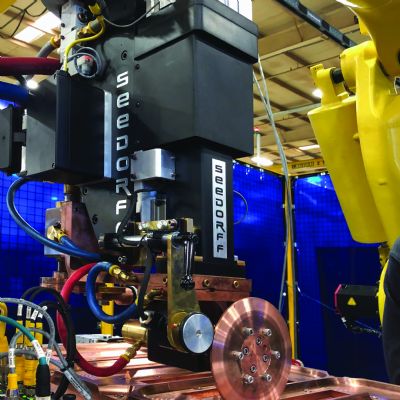Resistance Welding Guidance and Tips for Good Welds
April 24, 2020Comments
The amount of current used, weld time and electrode force pillars of successful welds form the basis of these tips from experts.
 Resistance welding in its simplest form: As two sheets of mild steel are pressed under a controlled force by copper-alloy electrodes, a controlled and timed electric current passes through the two sheets. As the highest circuit resistance occurs at the sheets’ point of contact, this is where the weld current generates heat and causes a weld nugget to grow. After the current stops, with the sheets held under pressure, the molten material from the two pieces flow together and solidify to form a weld. The term resistance welding owes to the fact that the electrical property of resistance of the metal being welded causes heat generation as current flows through it.
Resistance welding in its simplest form: As two sheets of mild steel are pressed under a controlled force by copper-alloy electrodes, a controlled and timed electric current passes through the two sheets. As the highest circuit resistance occurs at the sheets’ point of contact, this is where the weld current generates heat and causes a weld nugget to grow. After the current stops, with the sheets held under pressure, the molten material from the two pieces flow together and solidify to form a weld. The term resistance welding owes to the fact that the electrical property of resistance of the metal being welded causes heat generation as current flows through it.
Current, Time and Force—The Three Keys
Important factors in proper formation of the molten area between the pieces of metal include the magnitude of current, the length of time that it flows and the force squeezing the parts together.
The optimum values of these parameters vary with the types of metal workpieces and their thicknesses. For commonly used 1⁄16-in.-thick low-carbon steel, typical current is 10,000 amps for 0.25 sec., with 600 lb. of electrode force. Resistance welding schedules are available through the American Welding Society-Resistance Welder Manufacturers Alliance and most welding-machine manufacturers.
Obtaining such high electrical current requires the use of a purpose-built resistance welding transformer, which transforms high factory voltage to low (safer) welding voltage. As it transforms voltage, it simultaneously transforms low factory current to high welding currents.
As for process weld currents and weld times, a resistance welding control is responsible for turning the current on and off and forms a critical part of the system. A relay or hand-operated switch might be considered, but is unsuitable given the relatively slow speed of such operation. In the preceding example, the current must be on for only 0.25 sec., difficult to accomplish in such a short amount of time, let alone to perform consistently. Internally in the weld control, the power device used to switch current on is known as the silicon controlled rectifier (SCR). It operates by virtue of the fact that a small electrical signal applied to the device allows it to turn on in a small fraction of a second and conduct a large amount of current. Removing the electrical signal allows the device to turn off again. Fast turn-on and turn-off are possible due to no mechanical moving parts. SCRs operate on solid-state semi-conductor principles similar to those that govern transistors. Popular technology currently in use, highly efficient (mid-frequency DC (MFDC) inverters, use balanced three phase power and improve the process with many advantages in control of current, millisecond time resolution and the ability to produce high power systems.







